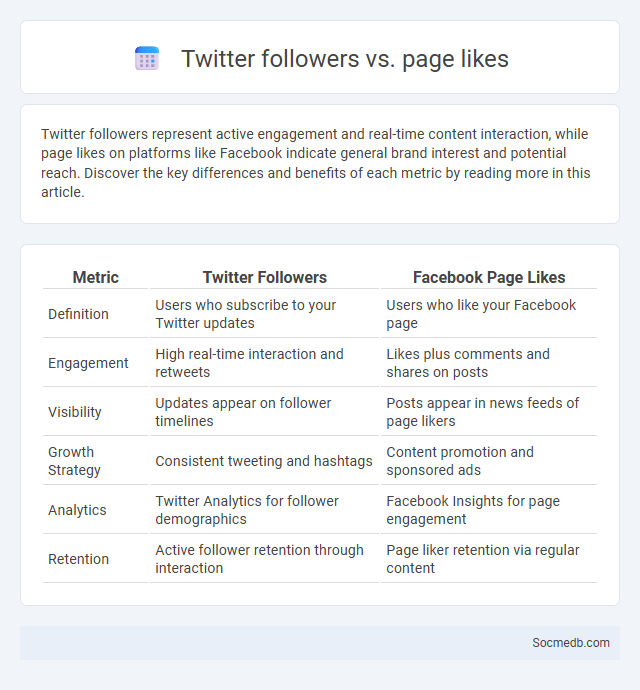
Photo illustration: Twitter followers vs page likes
Twitter followers represent active engagement and real-time content interaction, while page likes on platforms like Facebook indicate general brand interest and potential reach. Discover the key differences and benefits of each metric by reading more in this article.
Table of Comparison
| Metric | Twitter Followers | Facebook Page Likes |
|---|---|---|
| Definition | Users who subscribe to your Twitter updates | Users who like your Facebook page |
| Engagement | High real-time interaction and retweets | Likes plus comments and shares on posts |
| Visibility | Updates appear on follower timelines | Posts appear in news feeds of page likers |
| Growth Strategy | Consistent tweeting and hashtags | Content promotion and sponsored ads |
| Analytics | Twitter Analytics for follower demographics | Facebook Insights for page engagement |
| Retention | Active follower retention through interaction | Page liker retention via regular content |
Introduction: Understanding Social Media Metrics
Social media metrics provide essential data for evaluating the effectiveness of digital marketing campaigns and audience engagement on platforms like Facebook, Instagram, Twitter, and LinkedIn. Key metrics include reach, impressions, engagement rate, click-through rate (CTR), and conversion rates, which help businesses measure brand visibility and user interaction. Analyzing these metrics enables marketers to optimize content strategy, improve targeting, and increase return on investment (ROI).
What Are Twitter Followers?
Twitter followers are users who subscribe to receive updates and tweets from a specific account, increasing that account's reach and visibility on the platform. They play a crucial role in amplifying content, driving engagement, and building online communities within Twitter's social ecosystem. The number of followers often serves as a key metric for influence and social proof in digital marketing strategies.
Page Likes Explained
Page Likes represent the number of users who have chosen to follow your social media page, indicating interest in your content and brand. This metric helps gauge your audience size and potential reach, influencing your page's visibility in news feeds and recommendations. Engaging content and consistent interaction encourage more Page Likes, growing Your online presence effectively.
The Meaning of Followers Across Platforms
Followers on social media platforms such as Instagram, Twitter, and TikTok represent distinct forms of engagement and influence, varying by platform algorithms and user behavior. On Instagram, followers often indicate brand loyalty and visual content appreciation, while on Twitter, they reflect information reach and conversational interaction. TikTok followers are typically associated with content virality and trend participation, highlighting unique audience dynamics in short-form video sharing.
Engagement Rates: Followers vs Likes
Engagement rates on social media platforms often reveal significant disparities between followers and likes, with many accounts showing a high follower count but comparatively low post interactions. Algorithms prioritize content with higher likes, comments, and shares, making genuine engagement crucial for visibility and growth. Measuring engagement rate as the ratio of likes to followers provides valuable insight into the active audience and overall content effectiveness.
Reach and Visibility Differences
Social media platforms vary significantly in reach and visibility due to differing algorithms and user behaviors. Instagram and TikTok prioritize visual content, boosting engagement through hashtags and trending challenges, while Facebook emphasizes community groups and personalized news feeds for targeted reach. LinkedIn offers professional visibility by focusing on network connections and industry-specific content, making it ideal for B2B marketing and thought leadership.
Audience Quality and Demographics
Social media platforms offer detailed audience quality metrics, enabling advertisers to target demographics precisely based on age, gender, location, interests, and behavior patterns. High-quality audience targeting improves engagement rates by reaching users most likely to interact with content, enhancing return on investment for marketing campaigns. Leveraging demographic data facilitates personalized content delivery, boosting brand relevance and customer loyalty in competitive digital landscapes.
Impact on Brand Authority
Social media significantly enhances brand authority by providing a platform for consistent engagement, authentic storytelling, and real-time customer interaction. Your brand gains credibility when you share valuable content, respond promptly to feedback, and cultivate a loyal online community. This active presence establishes trust and positions your brand as an industry leader.
Choosing the Right Metric for Your Goals
Selecting the right social media metric depends on your specific business goals, such as brand awareness, engagement, or conversion rates. Metrics like reach and impressions are ideal for measuring awareness, while likes, comments, and shares indicate engagement levels. You should align your chosen metrics with clear objectives to accurately track social media performance and optimize your strategy.
Conclusion: Building Authentic Connections
Building authentic connections on social media requires consistent engagement and genuine interaction with your audience. Your content should reflect transparency and empathy to foster trust and loyalty among followers. Prioritizing meaningful relationships over follower count enhances long-term social media success and personal fulfillment.
 socmedb.com
socmedb.com